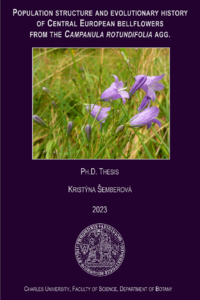Population structure and evolutionary history of Central European bellflowers from the Campanula rotundifolia agg.
Populační struktura a evoluční historie středoevropských zvonků z okruhu Campanula rotundifolia agg.
rigorózní práce (UZNÁNO)

Zobrazit/
Trvalý odkaz
http://hdl.handle.net/20.500.11956/180340Identifikátory
SIS: 258221
Kolekce
- Kvalifikační práce [20357]
Autor
Fakulta / součást
Přírodovědecká fakulta
Obor
Botanika
Katedra / ústav / klinika
Katedra botaniky
Datum obhajoby
22. 5. 2023
Nakladatel
Univerzita Karlova, Přírodovědecká fakultaJazyk
Angličtina
Známka
Uznáno
7 Abstrakt zace novinky. Campanula rotundifolia agg.) byl vy studium a . polyploidizace zdroj komplexu a a ved k posunu klady pro i jsou k ke v hybridizace s V C. rotundifolia a alopatrii. a o na a tetraploid , a to jak v mi ami, studovala jsem morfologickou v v by variabilita ve velikosti genomu, v gneice a morfoligii. Vysok variabilita, s m vysok C. rotundifolia m ch ch model ne y rekonstruovanou , jsem porovnala genetickou a morfologickou variabilitu a variabilitu ve velikosti genomu u rostlin z C. rotundifolia s. str. Morfologick podobnost a genetick C. bohemica a C. scheuchzeri z Alp byl C. gelida ve v C. rotundifolia subsp. sudetica. Campanula rotundifolia subsp. sudetica C. rotundifolia s. str. Campanula rotundifolia fenotypovou taxonomy : Campanula rotundifolia agg,
6 Abstract For understanding extant species diversity, knowledge about processes acting at the population level is crucial. Besides mutations generating de novo genetic variation, three major processes, i.e., polyploidy, hybridization and local adaptation, notably impact population structure and cause evolutionary novelty. Campanula rotundifolia agg. was chosen as a model group for the joint study of these processes because it represents a polyploid complex with three major cytotypes (2x, 4x, 6x), a hitherto unknown ability to hybridize, and a pleiad of putative species that have undergone local adaptation to different conditions. In particular, polyploidization in the complex is acknowledged for generating morphological variation, facilitating long-distance dispersal and shifts in the environmental niche. It also creates a reproductive barrier, thus enabling sympatric speciation. Prerequisites for local adaptation are morphological variation and strong selection pressures leading to adaptive divergence and the rise of many endemic taxa, mainly at the extremes of environmental gradients. On the other hand, for locally adapted or endemic taxa, hybridization with a widespread taxon is one of the main existential threats. Here, I focused on C. rotundifolia agg. populations in Central Europe its hypothetical...
